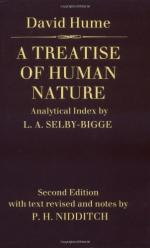What principally gives authority to this system is, beside the undoubted arguments, upon which each part is founded, the agreement of these parts, and the necessity of one to explain another. The belief, which attends our memory, is of the same nature with that, which is derived from our judgments: Nor is there any difference betwixt that judgment, which is derived from a constant and uniform connexion of causes and effects, and that which depends upon an interrupted and uncertain. It is indeed evident, that in all determinations, where the mind decides from contrary experiments, it is first divided within itself, and has an inclination to either side in proportion to the number of experiments we have seen and remember. This contest is at last determined to the advantage of that side, where we observe a superior number of these experiments; but still with a diminution of force in the evidence correspondent to the number of the opposite experiments. Each possibility, of which the probability is composed, operates separately upon the imagination; and it is the larger collection of possibilities, which at last prevails, and that with a force proportionable to its superiority. All these phenomena lead directly to the precedent system; nor will it ever be possible upon any other principles to give a satisfactory and consistent explication of them. Without considering these judgments as the effects of custom on the imagination, we shall lose ourselves in perpetual contradiction and absurdity.
SECT. XIV. OF THE IDEA OF NECESSARY CONNEXION.
Having thus explained the manner, in which we reason beyond our immediate impressions, and conclude that such particular causes must have such particular effects; we must now return upon our footsteps to examine that question, which [Sect. 2.] first occured to us, and which we dropt in our way, viz. What is our idea of necessity, when we say that two objects are necessarily connected together. Upon this head I repeat what I have often had occasion to observe, that as we have no idea, that is not derived from an impression, we must find some impression, that gives rise to this idea of necessity, if we assert we have really such an idea. In order to this I consider, in what objects necessity is commonly supposed to lie; and finding that it is always ascribed to causes and effects, I turn my eye to two objects supposed to be placed in that relation; and examine them in all the situations, of which they are susceptible. I immediately perceive, that they are contiguous in time and place, and that the object we call cause precedes the other we call effect. In no one instance can I go any farther, nor is it possible for me to discover any third relation betwixt these objects. I therefore enlarge my view to comprehend several instances; where I find like objects always existing in like relations of contiguity and succession. At first sight this seems to serve but little to my




